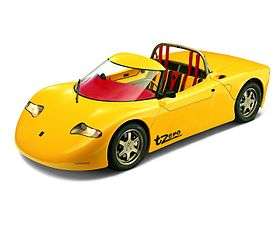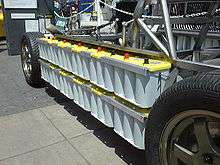AC Propulsion tzero
The tzero is a handmade electric sports car designed and built in very limited numbers by the U.S. company AC Propulsion in the early 2000s. It was the direct predecessor of the Tesla line of electric cars. The tzero was based on the Piontek Sportech kit car, which consists of a fiberglass body built over a reinforced steel space frame with double wishbone independent suspension and rack and pinion steering. AC Propulsion added the AC-150 drivetrain, a single-speed electric system with an overall gear ratio of 9:1.
| tzero | |
|---|---|
 The AC Propulsion tzero with the top off | |
| Overview | |
| Manufacturer | AC Propulsion |
| Body and chassis | |
| Class | Sports car |
| Body style | 2 passenger coupe |
| Layout | Rear mid-engine, rear-wheel drive |
| Platform | AC Propulsion AC150 |
| Related | |
Launched in January 1997, only three prototypes were built and plans for commercial production were dropped in mid-2003. The name comes from t0, the mathematical symbol for a starting point in time.[1] Due to high production costs, AC Propulsion ceased to produce the tzero. Only three were built,[2] one of which is owned by the company itself, one by Gruber Power Services, a company that specializes in Tesla Roadster repair, and one privately.
The drivetrain was used in many other vehicles. Because the car recharges its batteries when the throttle is released — slowing sharply as energy is recaptured — it can be driven hard using only the accelerator pedal. Also, if the car detects a turn with more than half a g-force (5 m/s²), it eases the rear-wheel regenerative braking to prevent slides.
Original lead-acid battery powered tzero

The original version of the roadster ran on 28 Johnson Controls Optima Yellow Top lead-acid batteries in series, which produced 150 kW (200 horsepower) and 177 lbs·ft (240 N·m) of torque at 336 volts and accelerated the 1,040 kg (2,290 lb) car from a standstill to 60 mph (97 km/h) in 4.07 seconds. The single gear ratio limited the car's maximum speed to 90 mph (140 km/h) at 12,000 rpm, although it is said that early prototypes fitted with multiple gear ratios could hit 155 miles per hour (249 km/h). Even with the single ratio, lead-acid models are capable of completing a quarter mile (400 m) drag race in 13.24 seconds. The expected range per charge of the tzero with the lead-acid batteries is 80 to 100 mi (130 to 160 km) as a result of consuming only 180 watt hours per mile (895 J/km) (DC) on the highway and due to regenerative braking. The car could be charged from 0 to 95% within an hour. The base price of this version was to have been US$80,000.
Lithium-ion battery conversion
Martin Eberhard was contacted by Tom Gage about the tZero car which he had built, and was currently converting to lithium batteries, similar to those that make up the battery packs of laptop computers.. He stated that Eberhard had multiple "Schemes" and that he had to explain to Eberhard how unfeasible most of his concepts were.[3].[4][3] The conversion was done over six months from March through September, 2003 and gave the tzero a 300-mile (480 km) range.[5] Lighter than the original version by 500 lb (230 kg), the lithium-ion conversion goes from 0–60 mph (0–97 km/h) in 3.6 seconds. The single gear ratio limits the car's maximum speed to just over 140 mph (230 km/h) at 13,000 rpm with proper gearing, though it has never been tested at greater than the electronic limit of 105 mph (169 km/h). The base price of the car was US$220,000. Elon Musk and Martin Eberhard encouraged Tom Gage and Alan Cocconi to move the lithium-ion powered prototype into production. Eberhard then borrowed the converted tzero for three months and used it as a daily driver.[3][6]
JB Straubel then told Elon Musk about the newly converted, now lithium-ion powered tzero and arranged a test drive. Musk also encouraged AC Propulsion to commercialize the vehicle.[4] Tom Gage, however, again deferred in favor of working on their electrified Scion xB called the eBox; but, he put Elon Musk in contact with Martin Eberhard[7] which led to Elon Musk's Series A funding of Tesla Motors in April, 2004 and their hiring JB Straubel.[6]
Long Ranger genset trailer

AC Propulsion also built a portable internal combustion powered generator mounted on a trailer known as the Long Ranger that can be towed behind the car and feed power to the batteries during travel. The trailer uses a 500 cc Kawasaki engine with a 9.5 U.S. gallon (40 liter) fuel tank and achieved 30–35 mpg‑US (7.8–6.7 L/100 km; 36–42 mpg‑imp) in highway driving over at least 20,000 mi (32,000 km). It is rated at 20 kW (27 hp) DC output and can maintain 60–80 mph (97–129 km/h). The trailer incorporates a novel "backtracking" feature that automatically steers the trailer wheels allowing even novice drivers to easily back a trailer through complex maneuvers; the company published a video demonstrating the ease with which the trailer could be backed through a set of slalom cones.
Production fate
As of 2017 only one tzero remains. Gruber Motor Company's car was destroyed in a building fire in May 2017.[2]
See also
- AC Propulsion eBox
- La Jamais Contente
- Keio University Eliica
- Lightning GT
- Tesla Roadster (2008)
- Think Global AS
- Venturi Fétish
- Wrightspeed X1
References
- "Archived copy". Archived from the original on 2014-07-14. Retrieved 2014-06-10.CS1 maint: archived copy as title (link)
- Fred Lambert (11 May 2017). "A piece of electric car history up in flames: several Tesla Roadsters and original Tzero lost in devastating fire". Electrek.
- Morris, Charles (2014-04-07). "Tom Gage on ZEV mandates, Tesla's early days, BMW's EV commitment and V2G tech". Charged Electric Vehicles Magazine.
Gage: I had a neighbor named Steve Casner, who had a Toyota RAV4 electric, and I always had an EV in my front yard, so we got to talking. He was working at a company with Martin Eberhard, so he told Martin about me. Martin called me, and he had all these schemes, and I was sort of talking through what the realities were. We were just converting the tzero over to lithium-ion batteries. He got involved with that. He actually put some investor money – a small amount – into AC Propulsion, and we finished the conversion of the tzero to lithium-ion batteries.
- Shnayerson, Michael (2007-05-14). "Quiet Thunder". CondéNet.
Musk isn't the one who had the Eureka! moment. That was […] Martin Eberhard. Like anyone else in 2003, the then 43-year-old Eberhard knew that billion-dollar markets had grown almost overnight for laptop computers and cell phones. Rivals were spending huge sums on R&D to pack ever more energy into the lithium-ion batteries that powered those devices. One day Eberhard had a simple thought: Why not put lithium-ion cells into cars? […] Eberhard commissioned a shy, gifted, sometimes difficult California pioneer of electric vehicles named Alan Cocconi to put a pack of lithium-ion batteries into Cocconi's latest electric-vehicle kit car, the T Zero.
- Chow, Yee (2003-09-15). "AC Propulsion Debuts tzero with LiIon" (PDF). San Dimas, CA: AC Propulsion. Archived from the original (PDF) on 2016-03-04. Retrieved 2014-11-06.
- Taylor, Michael (2006-08-09). "Hot sports car with no gas tank / Electric roadster's maker says it does 130 mph -- but it doesn't come cheap". S.F. Chronicle.
Eventually, he got in touch with Tom Gage, president of AC Propulsion, a San Dimas (Los Angeles County) firm that had already made the TZero, a brutally fast electric-powered sports car. AC had made only a few cars, and Eberhard says he invested in the company and drove its lithium ion-battery-powered car for about three months "as a daily driver."
- Siry, Daryl (2009-06-25). "Will the Real Tesla Founder Please Stand Up?". Wired. Condé Nast.
...it is interesting to note that neither Martin Eberhard or Elon Musk came up with the idea of an electric sportscar with excellent range and amazing acceleration. As is evident in some of the emails Elon presents on his blog, the credit rests with a company few outside EV circles has heard of. AC Propulsion developed the idea [using lead-acid batteries originally], and both Eberhard and Musk initially approached the San Dimas, California, company to build the car. Tom Gage and Alan Cocconi had built the t zero, which is essentially the prototypical Tesla Roadster with a 0-60 time of 3.6 seconds and a range of more than 200 miles using [the upgraded] commodity lithium-ion cells. One way to look at this is the real technology visionaries were the folks at AC Propulsion, but they lacked the entrepreneurial vision to see just how big an idea it could become and the means to achieve it. Both Eberhard and Musk saw the importance — and potential — of what Gage and Cocconi had created. When Eberhard and Musk approached them individually to prod them into taking the next step and produce the vehicle, Gage opted instead to introduce Musk to Eberhard and get back to work creating the eBox, an electrified Scion xB that Gage considered more practical and economical.
External links
| Wikimedia Commons has media related to AC Propulsion tzero. |
- Lots of Zoom, With Batteries The New York Times, September 19, 2003